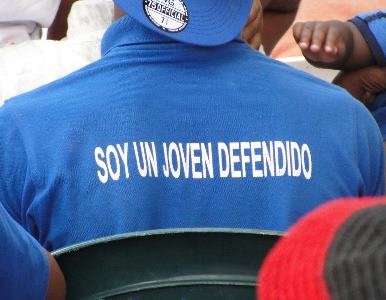CHURCH & MINISTRY
Compassion International in the Dominican Republic
Context and Overview
By Kersley Fitzgerald

From 10-14 April, 2014, Compassion International hosted the GotQuestions team in a tour of their work in the Dominican Republic. This, the first of many reports that will come from that trip, will cover the culture and challenges of living in the DR and give a quick overview of Compassion's work there.
The Dominican Republic is the nation covering the south-eastern 5/8s of the island of Hispaniola (Haiti covers the northern and western part), just southeast of Cuba. It's about the size of South Carolina. The capital, Santo Domingo, is 826 miles almost directly southeast of Miami.
Columbus landed on the island in 1492, starting several hundred years of power shifts, colonization, slave-trading, and general drama. Within fifty years, the indigenous population went from 1 million to 500. Various colonizers brought in slaves from Africa to tend to the sugarcane plantations. Residents today are a generous mix of Native, African, Caucasian, Spanish, and even immigrants from Asia and the Middle East. Most are native Dominicans, but there are at least 800,000 Haitian residents and undocumented Haitian migrants. Past racism and government-sponsored discrimination have led most to downplay their ethnicities — a move which seems to somewhat limit racial tensions. But tension is increasing as the governments of both the Dominican Republic and Haiti refuse to naturalize children born to Haitian parents in the DR.
The internal structure of the Dominican Republic is not great. Corruption is a historical fact. Utilities are unstable (trash service is nearly non-existent, power outages are frequent (especially in rural areas), and tap water is non-potable). The sugarcane industry has been demolished by foreign investors, leaving the nation largely dependent on tourism for survival. After decades of self-seeking presidents, Danilo Medina was elected in 2012 and has already made great strides on his promises to drastically improve literacy rates and decrease corruption in the military. The literacy rate in the Dominican Republic now stands at an impressive 90.1%, 6% over the world average.
The Dominican Republic is largely Catholic; our in-country guide contradicted Wikipedia, giving the numbers as 80% Catholic, 15% Protestant, and 5% Haitian Vodou, with a smattering of others, including Judaism. There is little-to-no religious tension between the groups.
Baseball is huge in the DR, and Dev and our senior editor spent much time talking about DR nationals who played for the Royals. But perhaps the most famous person to come out of the DR is fashion designer Oscar de la Renta. This clicked something for me — our guide explained that personal appearance is extremely important in the DR. A family may live in a shack with an outside toilet, but their clothes will be nice and clean. Denim pencil skirts and Converse (high- and low-tops) were everywhere. Boys wore collared shirts (although I noticed some were hand-me-down professional wear, complete with their original female owner's name embroidered on the chest); girls wore nice sandals and always had their hair done. One father asked us to pray he'd have money to feed his children while standing in new, freshly-pressed jeans.
Another anomaly we noticed were the number of complete families. Probably due to the Catholic influence, most of the homes we visited included married parents. And two of the fathers kept their jobs despite their employers' inability to pay.
Which leads to my pet-issue: trafficking. According to Wikipedia, "Human trafficking in the Dominican Republic is the third largest international crime enterprise in the Caribbean, generating 9.5 billion U.S. dollars annually." Yeah. Let that sink in. With all the drugs that come through the Caribbean, trafficking in people in the DR is #3. Poverty, dependence on tourism (including sex-tourism), and general disrespect toward women result in tens of thousands of victims. Women are shipped out to other countries — or brought in from other countries. Kids (especially undocumented Haitian refugees) are sold in the touristy beach areas. And men and women (including Haitian migrants) are used for unpaid labor in the DR or taken to the US and Argentina for domestic and agricultural work. Although the government does crack down on the drug trade — somewhat — work against trafficking is only slowly increasing. In the last two years, trafficking in the Dominican Republic has improved from Tier 3 to Tier 2.
Other organizations are putting on the pressure. Last year, the International Organization for Migration helped DR authorities identify and rescue 54 Haitian kids who were forced into street selling. The International Justice Mission is in the process of opening an office in Santo Domingo. Their work protecting widows in Africa and freeing brick-factory slaves in India has been phenomenal — expect big things from them in the DR.
Compassion International got to the DR in 1970. They support 167 child development centers that provide assistance to nearly 50,000 kids. Their goal is not to go in on a white horse and save the world, but to work within the format Christ gave us. They support the efforts of individual churches. The churches are responsible for finding the kids, determining the communities' needs, and following the guidelines put forth by Compassion. The local Compassion staff monitors their work and gets them the resources to get things done.
Continue to Page Two
Image Credits
Photo One: "I am a defended child"; shirt given to boys at the first Project; Kersley Fitzgerald
comments powered by Disqus
Published 4-18-14

